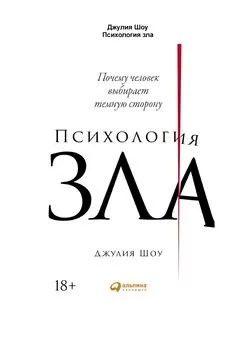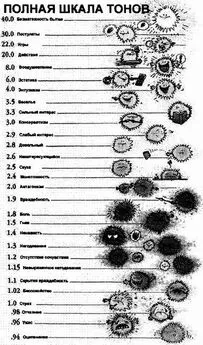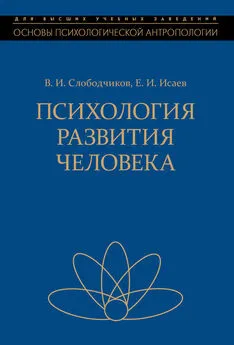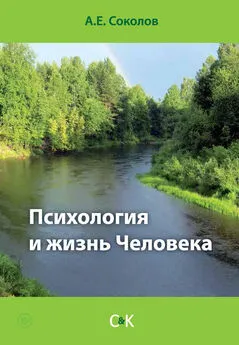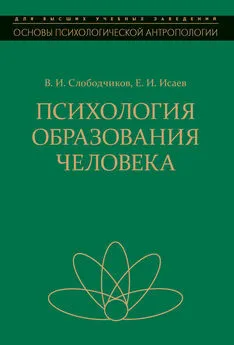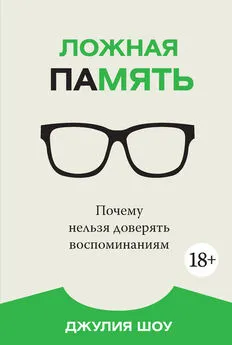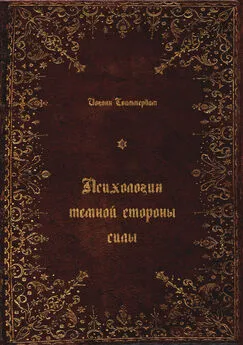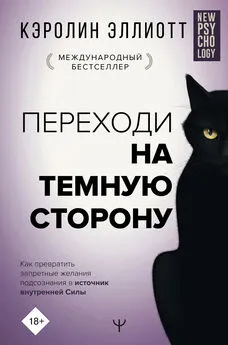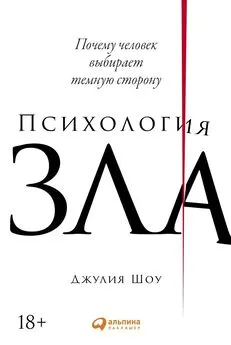Джулия Шоу - Психология зла. Почему человек выбирает темную сторону
- Название:Психология зла. Почему человек выбирает темную сторону
- Автор:
- Жанр:
- Издательство:Альпина Паблишер
- Год:2020
- Город:Москва
- ISBN:978-5-9614-3544-3
- Рейтинг:
- Избранное:Добавить в избранное
-
Отзывы:
-
Ваша оценка:
Джулия Шоу - Психология зла. Почему человек выбирает темную сторону краткое содержание
«Психология зла» - это подробное и увлекательное исследование темной стороны человека. Доктор Джулия Шоу на примерах из массовой культуры и реальной жизни предлагает порассуждать о проблемах, о которых обычно молчат, хотя знание факторов, способных спровоцировать недопустимое поведение, помогает замечать их и не давать им развернуться в полную силу.
Психология зла. Почему человек выбирает темную сторону - читать онлайн бесплатно ознакомительный отрывок
Интервал:
Закладка:
133
Ehrenfeld, J. M. ‘WannaCry, cybersecurity and health information technology: a time to act’. Journal of Medical Systems, 41 (7) (2017), p. 104.
134
Bjerg, O. ‘How is bitcoin money?’ Theory, Culture & Society, 33 (1) (2016), pp. 53-72.
135
Barlett, C. P., Gentile, D. A., & Chew, C. ‘Predicting cyberbullying from anonymity’. Psychology of Popular Media Culture, 5 (2) (2016), p. 171.
136
Rösner, L., & Krämer, N. C. ‘Verbal venting in the social web: effects of anonymity and group norms on aggressive language use in online comments’. Social Media + Society, 2 (3) (2016); https://doi.org/10.1177/2056305116664220.
137
Huang, G., & Li, K. ‘The effect of anonymity on conformity to group norms in online contexts: a meta-analysis’. International Journal of Communication, 10 (2016), p. 18.
138
Sticca, F., & Perren, S. ‘Is cyberbullying worse than traditional bullying? Examining the differential roles of medium, publicity, and anonymity for the perceived severity of bullying’. Journal of Youth and Adolescence, 42 (5) (2013), pp. 739-50.
139
Cheng, J., Bernstein, M., Danescu-Niculescu-Mizil, C., & Leskovec, J. ‘Anyone can become a troll: causes of trolling behavior in online discussions’. Proceedings of the 2017 ACM Conference on Computer Supported Cooperative Work and Social Computing (2017). arXiv:1702.01119 [cs.SI]; http://doi.org/10.1145/2998181.2998213.
140
Однако, по крайней мере в ЕС, есть право на забвение: см., напр.: Управление комиссара по вопросам информации в Великобритании, Генеральный регламент по защите данных, «Право на удаление данных» (Right to Erasure); https://ico.org.uk/for-organisations/data-protection-reform/overview-of-the-gdpr/individuals-rights/the-right-to-erasure/.
141
Kink (англ.) — «странность», «извращение», часто применяется для обозначения нестандартных сексуальных практик. — Прим. ред.
142
Dawson, S. J., Bannerman, B. A., & Lalumiere, M. L. ‘Paraphilic interests: an examination of sex differences in a nonclinical sample’. Sexual Abuse, 28 (1) (2016), pp. 20-45.
143
American Psychiatric Association. Diagnostic and Statistical Manual of Mental Disorders (5th ed.). Arlington, VA: APA, 2013.
144
Joyal, C. C. ‘How anomalous are paraphilic interests?’ Archives of Sexual Behavior, 43 (7) (2014), pp. 1241-43.
145
Scorolli, C., Ghirlanda, S., Enquist, M., Zattoni, S., & Jannini, E. A. ‘Relative prevalence of different fetishes’. International Journal of Impotence Research, 19 (2007), pp. 432-37.
146
Längström, N., & Seto, M. C. ‘Exhibitionistic and voyeuristic behavior in a Swedish national population survey’. Archives of Sexual Behavior, 35 (2006), pp. 427-35; http://doi.org/10.1007/s10508-006-9042-6.
147
Holvoeta, L., Huysb, W., Coppensa, V., Seeuwsd, J., . . . & Morrensa, M. ‘Fifty shades of Belgian grey: the prevalence of BDSM-related fantasies and activities in the general population’. Journal of Sexual Medicine, 14 (9) (2017), pp. 1152-59.
148
Lammers, J., & Imhoff, R. ‘Power and sadomasochism: understanding the antecedents of a knotty relationship’. Social Psychological and Personality Science, 7 (2) (2016), pp. 142-48.
149
Leitenberg, H., & Henning, K. ‘Sexual fantasy’. Psychological Bulletin, 117 (3) (1995), p. 469.
150
Engber, D. ‘“Cannibal Cop”: an exclusive interview with Gilberto Valle’. Slate, 10 December 2015; http://www.slate.com/articles/news_and_politics/crime/2015/12/cannibal_cop_an_exclusive_intervi ew_with_gilberto_valle .html.
151
Weiser, B. ‘Ex-officer’s conviction in cannibal case shouldn’t be reinstated, appeals court rules’. The NewYork Times, 4 December 2015; https://www.nytimes.com/2015/12/04/nyregion/appeals-court-gilberto-valle-cannibal-case.html.
152
Volokh, E. ‘Second Circuit rules for accused “cannibal cop”’. Washington Post, 3 December 2015; https://www.washingtonpost.com/news/volokh-conspiracy/wp/2015/12/03/second-circuit-rules-for-accused-cannibal-cop/?utm_term=.b96a52e809a9.
153
Bivona, J., & Critelli, J. ‘The nature of women’s rape fantasies: an analysis of prevalence, frequency, and contents’. Journal of Sex Research, 46 (1) (2009), pp. 33-45.
154
Joyal, C. C., Cossette, A., & Lapierre, V. ‘What exactly is an unusual sexual fantasy?’ Journal of Sexual Medicine, 12 (2) (2015), pp. 328-40.
155
Paul, P Pornified. New York: Times Books, 2007.
156
Perry, S. L., & Schleifer, C. ‘Till porn do us part? A longitudinal examination of pornography use and divorce’. Journal of Sex Research (2017), pp. 1-13.
157
Perry, S. L. ‘Pornography consumption as a threat to religious socialisation’. Sociology of Religion, 76 (4) (2015), pp. 436-58.
158
Wright, P. J., Tokunaga, R. S., & Kraus, A. ‘A meta-analysis of pornography consumption and actual acts of sexual aggression in general population studies’. Journal of Communication, 66 (1) (2016), pp. 183-205.
159
Kühn, S., & Gallinat, J. ‘Brain structure and functional connectivity associated with pornography consumption: the brain on porn’. JAMA Psychiatry, 71 (7) (2014), pp. 827-34.
160
Moran, C., & Lee, C. ‘What’s normal? Influencing women’s perceptions of normal genitalia: an experiment involving exposure to modified and nonmodified images’. BJOG: An International Journal of Obstetrics & Gynaecology, 121 (6) (2014), pp. 761-66.
161
Hesse, C., & Pedersen, C. L. ‘Porn sex versus real sex: how sexually explicit material shapes our understanding of sexual anatomy, physiology, and behaviour’. Sexuality & Culture, 21 (3) (2017), pp. 754-75.
162
Carroll, A. & Mendos, L. R., International Lesbian, Gay, Bisexual, Trans and Intersex Association. State-Sponsored Homophobia 2017: A World Survey of Sexual Orientation Laws: Criminalisation, Protection and Recognition; http://ilga.org/what-we-do/state-sponsored-homophobia-report/.
163
Sweeney, J. ‘Sochi 2014: No gay people in city’. Interview with Anatoly Pakhomov for BBC Panorama, 27 January 2014; http://www.bbc.com/news/uk-25675957.
164
Gates, G. J. ‘How many people are lesbian, gay, bisexual and transgender?’ The Williams Institute, UCLA School of Law (2011); https://escholarship.org/content/qt09h684x2/qt09h684x2.pdf.
165
Duncan, P ‘Gay relationships are still criminalised in 72 countries, report finds’. The Guardian, 27 July 2017; https://www.theguardian.com/world/2017/jul/27/gay-relationships-still-criminalised-countries-report.
166
Sanders, A. R., Martin, E. R., Beecham, G. W., Guo, S., . . . & Duan, J. ‘Genome-wide scan demonstrates significant linkage for male sexual orientation’. Psychological Medicine, 45 (7) (2015), pp. 1379-88.
167
Coghlan, A. ‘Largest study of gay brothers homes in on “gay genes”’. New Scientist, 17 November 2014; https://www.newscientist.com/article/dn26572-largest-study-of-gay-brothers-homes-in-on-gay-genes/.
168
Adams, H. E., Wright, L. W., & Lohr, B. A. ‘Is homophobia associated with homosexual arousal?’ Journal of Abnormal Psychology, 105 (3) (1996), p. 440.
169
Wagner, G. J. ‘Internalised homophobia scale’. In: Handbook of Sexuality-Related Measures, Clive Davis, William Yarber et al. Thousand Oaks, CA: SAGE Publications, 1998, pp. 371-72.
170
Tskhay, K. O., & Rule, N. O. ‘Internalised homophobia influences perceptions of men’s sexual orientation from photos of their faces’. Archives of Sexual Behavior, 46 (3) (2017), pp. 755-61.
171
Alarie, M., & Gaudet, S. ‘“I don’t know if she is bisexual or if she just wants to get attention”: analyzing the various mechanisms through which emerging adults invisibilise bisexuality’. Journal of Bisexuality, 13 (2) (2013), pp. 191-214.
172
Herek, G. M. ‘Heterosexuals’ attitudes toward bisexual men and women in the United States’. Journal of Sex Research, 39 (4) (2002), pp. 264-74.
173
de Zavala, A. G., Waldzus, S., & Cypryanska, M. ‘Prejudice towards gay men and a need for physical cleansing’. Journal of Experimental Social Psychology, 54 (2014), pp. 1-10.
174
LaCour, M. J., & Green, D. P ‘When contact changes minds: an experiment on transmission of support for gay equality’. Science, 346 (6215) (2014), pp. 1366-69.
175
Williams, C. J., & Weinberg, M. S. ‘Zoophilia in men: a study of sexual interest in animals’. Archives of Sexual Behavior, 32 (6) (2003), pp. 523-35.
176
Sangeeta, S. ‘Health risks of zoophilia/bestiality’. Journal of Biological and Medical Sciences, 1 (1) (2017), e101.
177
Kennedy, A. C., & Prock, K. A. ‘“I still feel like I am not normal”: a review of the role of stigma and stigmatisation among female survivors of child sexual abuse, sexual assault, and intimate partner violence’. Trauma, Violence, & Abuse (November 2016); https://doi.org/10.1177/1524838016673601.
178
Blakemore, T., Herbert, J. L., Arney, F., & Parkinson, S. ‘The impacts of institutional child sexual abuse: a rapid review of the evidence’. Child Abuse & Neglect, 74 (2017), pp. 35-48.
179
McCartan, K. ‘“Here There Be Monsters”: the public’s perception of paedophiles with particular reference to Belfast and Leicester’. Medicine, Science and the Law, 44 (4) (2004), pp. 327-42.
180
Jahnke, S., Imhoff, R., & Hoyer, J. ‘Stigmatisation of people with pedophilia: two comparative surveys’. Archives of Sexual Behavior, 44 (1) (2015), pp. 21-34.
181
Wurtele, S. K., Simons, D. A., & Moreno, T. ‘Sexual interest in children among an online sample of men and women: prevalence and correlates’. Sexual Abuse, 26 (6) (2014), pp. 546-68.
182
American Psychiatric Association. Diagnostic and Statistical Manual of Mental Disorders (4th ed.). Washington, DC: APA, 2000.
183
Sea, J., & Beauregard, E. ‘The hebephiliac: pedophile or teleiophiliac?’ International Journal of Offender Therapy and Comparative Criminology (2017); https://doi .org/10.1177/0306624X17723627.
184
Bailey, J. M., Hsu, K. J., & Bernhard, P A. ‘An internet study of men sexually attracted to children: sexual attraction patterns’. Journal of Abnormal Psychology, 125 (7) (2016), p. 976.
Читать дальшеИнтервал:
Закладка:
